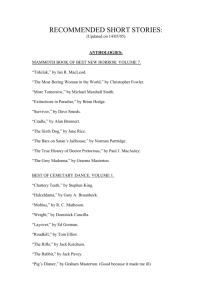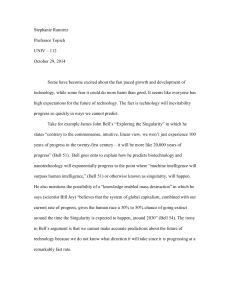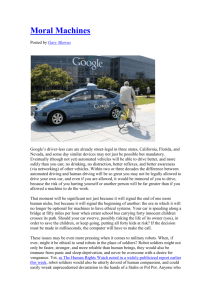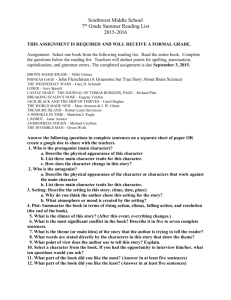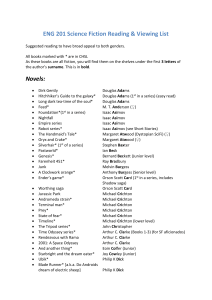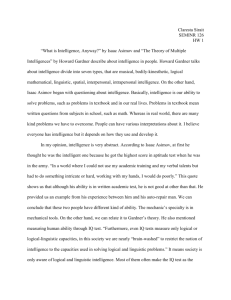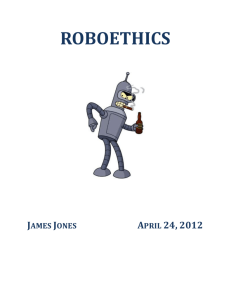Isaac Asimov was born in Petrovich, Russia on January 2, 1920
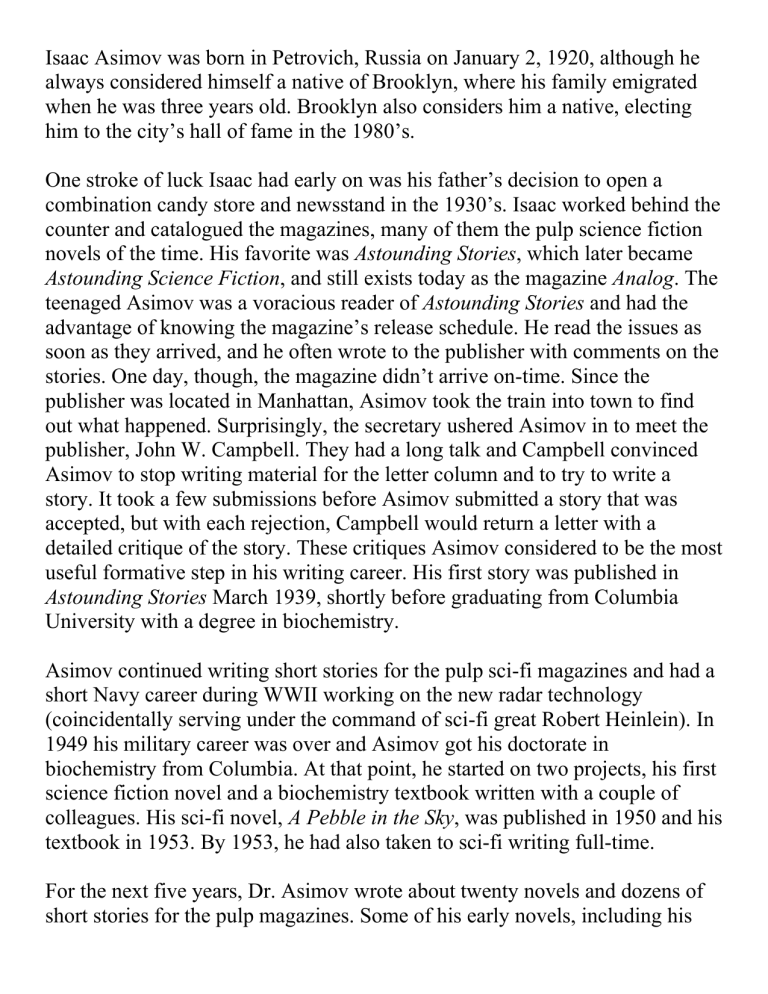
Isaac Asimov was born in Petrovich, Russia on January 2, 1920, although he always considered himself a native of Brooklyn, where his family emigrated when he was three years old. Brooklyn also considers him a native, electing him to the city’s hall of fame in the 1980’s.
One stroke of luck Isaac had early on was his father’s decision to open a combination candy store and newsstand in the 1930’s. Isaac worked behind the counter and catalogued the magazines, many of them the pulp science fiction novels of the time. His favorite was Astounding Stories , which later became
Astounding Science Fiction , and still exists today as the magazine Analog . The teenaged Asimov was a voracious reader of Astounding Stories and had the advantage of knowing the magazine’s release schedule. He read the issues as soon as they arrived, and he often wrote to the publisher with comments on the stories. One day, though, the magazine didn’t arrive on-time. Since the publisher was located in Manhattan, Asimov took the train into town to find out what happened. Surprisingly, the secretary ushered Asimov in to meet the publisher, John W. Campbell. They had a long talk and Campbell convinced
Asimov to stop writing material for the letter column and to try to write a story. It took a few submissions before Asimov submitted a story that was accepted, but with each rejection, Campbell would return a letter with a detailed critique of the story. These critiques Asimov considered to be the most useful formative step in his writing career. His first story was published in
Astounding Stories March 1939, shortly before graduating from Columbia
University with a degree in biochemistry.
Asimov continued writing short stories for the pulp sci-fi magazines and had a short Navy career during WWII working on the new radar technology
(coincidentally serving under the command of sci-fi great Robert Heinlein). In
1949 his military career was over and Asimov got his doctorate in biochemistry from Columbia. At that point, he started on two projects, his first science fiction novel and a biochemistry textbook written with a couple of colleagues. His sci-fi novel, A Pebble in the Sky , was published in 1950 and his textbook in 1953. By 1953, he had also taken to sci-fi writing full-time.
For the next five years, Dr. Asimov wrote about twenty novels and dozens of short stories for the pulp magazines. Some of his early novels, including his
acclaimed Foundation series and his Robot series, were expansions or collections of stories published earlier in the magazines. This eventually became Asimov’s signature. While he did write several full-length novels from whole-cloth, he did prefer to “try out” stories in the magazines and later collect them or expand them into books. After about five years of voracious sci-fi writing, Asimov took a 25 year semi-break from fiction to write science books.
I say “semi-break” because Asimov did work on one of his most famous stories in 1966, Fantastic Voyage . He never thought much of Fantastic Voyage for a few reasons:
1.
He didn’t really write it. The studio already had a completed screenplay and had largely completed filming the very expensive film, but they wanted to ensure that it would appeal to science fiction fans, so they hired
Asimov. Asimov considered the novelized screenplay to be an easy paycheck.
2.
Asimov considered the science in Fantastic Voyage to be ridiculous.
Where Asimov’s novel differed from the screenplay was usually Asimov correcting some of the movie’s bad science. He enjoyed the fact that his
12 year-old niece, with whom he attended the movie’s premiere, commented that a white blood cell could not digest a miniature submarine so completely that they wouldn’t need to retrieve it before it grew to normal size and killed the patient.
3.
Asimov didn’t mention this specifically, but the movie made it very clear at the end that the villain was an atheist who was trying to kill the patient because there was no god. I notice that this scene didn’t make into the novel.
In any case, from 1959 until his death, Asimov declared himself to be “The
Great Explainer” and threw himself into writing about every subject about which he had any interest. He released dozens of books about science and astronomy, some of which were collections of nonfiction articles written for other magazines. He wrote a nine-volume series for kids about the planets, with each volume covering a particular planet. He wrote thousand-page
commentaries on The Bible and the works of Shakespeare. He released annotated editions of Don Juan , Paradise Lost , Gulliver’s Travels , and the works of Gilbert & Sullivan. He wrote two dozen books on physics, a couple dozen on biology, at least fifty general books on space, covering everything from Halley’s Comet to UFO’s, about twenty books of the histories of various regions of the world, and a dozen more volumes on The Bible, mostly dealing with early Jewish history, about which he had an interest because of his devoutly Jewish father.
He even wrote a book of dirty limericks!
All told, Asimov wrote over 300 books. The exact number is hard to say because he did so many books that were collections of stuff in other books or magazines, collections of hand-chosen stories written by other up-and-coming science fiction writers, and a few later books that were “co-authored” (read ghostwritten) expansions of some of his early short stories. In any case,
Asimov was one of the most prolific writers ever, and he is the only writer in anyone’s memory who has published works in all ten Dewey Decimal categories.
Asimov died in 1992 of kidney and liver failure brought on by HIV that he contracted several years earlier during a heart bypass operation. Indications were that Asimov never regretted the end of his life and considered the extra years he got to be a bonus, as the bypass operation extended his life by several years.
Asimov’s Atheism
Isaac Asimov was a lifelong atheist, but he also liked to state that he was a staunch humanist, as just saying he was an atheist made it clear what he didn’t believe, but not what he did . He was one of the signers of Humanist Manifesto
II in the 1970’s, and he was the president of the American Humanist
Association from 1985 until his death. He was a staunch opponent of all kinds of pseudoscience and his novels contained a welcome absence of any kind of mystical mumbo-jumbo that writers like L. Ron Hubbard were popularizing.
He also liked to have fun at the expense of his longtime literary collaborator,
John Campbell, who appeared to buy into every piece of pseudoscientific nonsense that crossed his desk. One month he’d be showing Asimov some new nonsense called Dianetics, while the next month, Campbell would be showing him a plastic sphere with colored lights that was supposed to assess your personality by the way your hand felt when certain colors were glowing.
Asimov was originally reluctant to accept the invitation to be president of
AHA, as he’d lost a couple of subscriptions to his new self-published magazine Isaac Asimov’s Science Fiction Magazine when he wrote some particularly pro-humanist editorials. He figured, though, that the humanist camel’s nose was already under the tent, so he became president and never regretted it.
I’ll close with a quote from Asimov that has appeared on the Metroplex
Atheists website since 1999. It was a response to a question about why he fights superstition with no chance to win:
Because we must. Because we have the call. Because it is nobler to fight for rationality without winning than to give up in the face of continued defeats. Because whatever true progress humanity makes is through the rationality of the occasional individual and because any one individual we may win for the cause may do more for humanity than a hundred thousand who hug superstition to their breasts.

